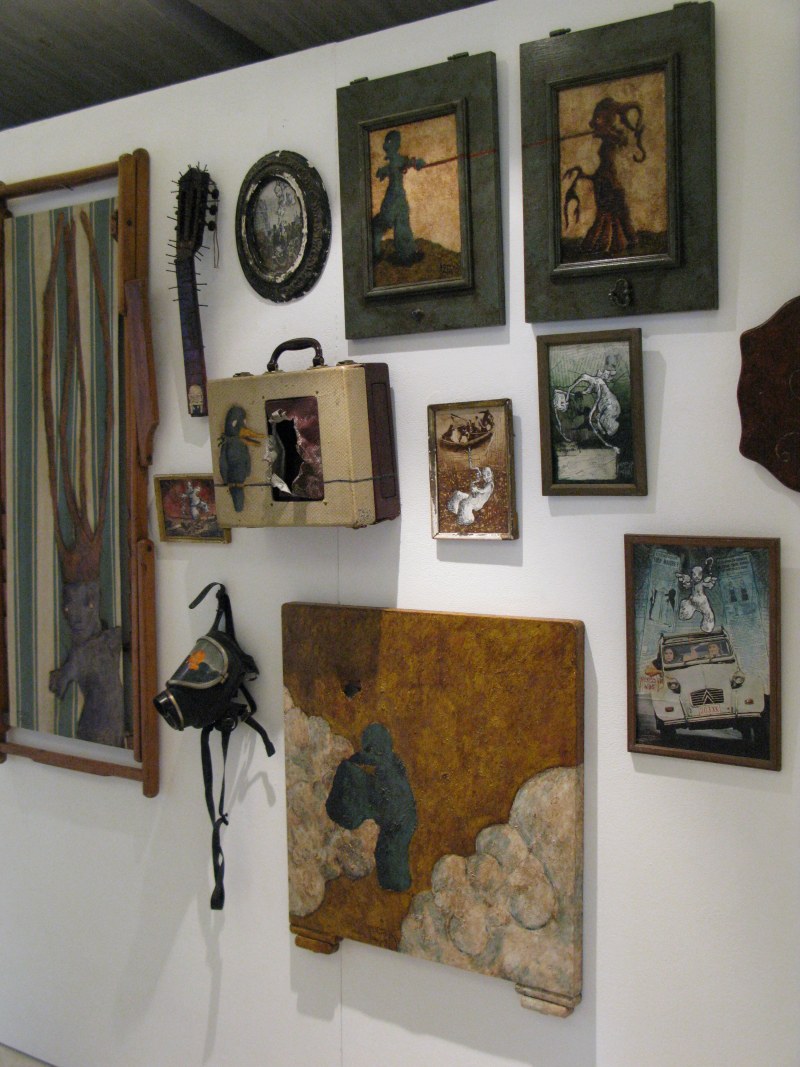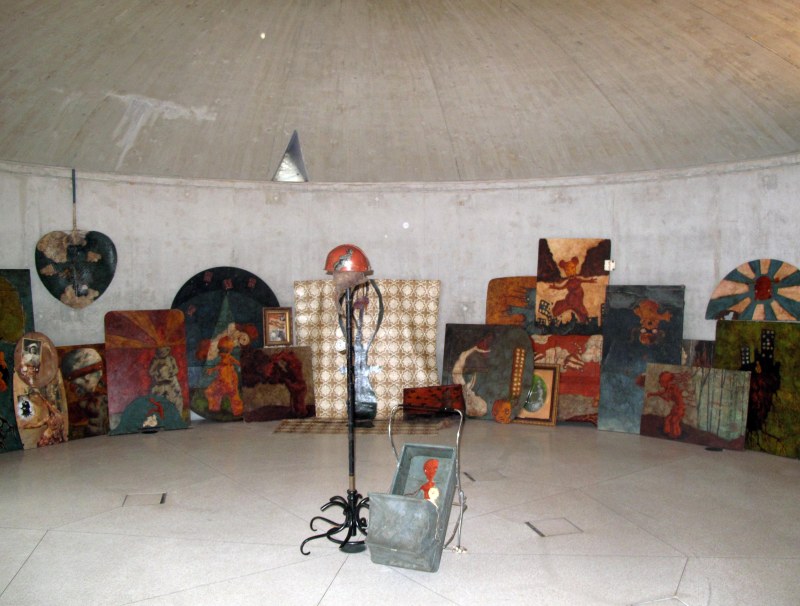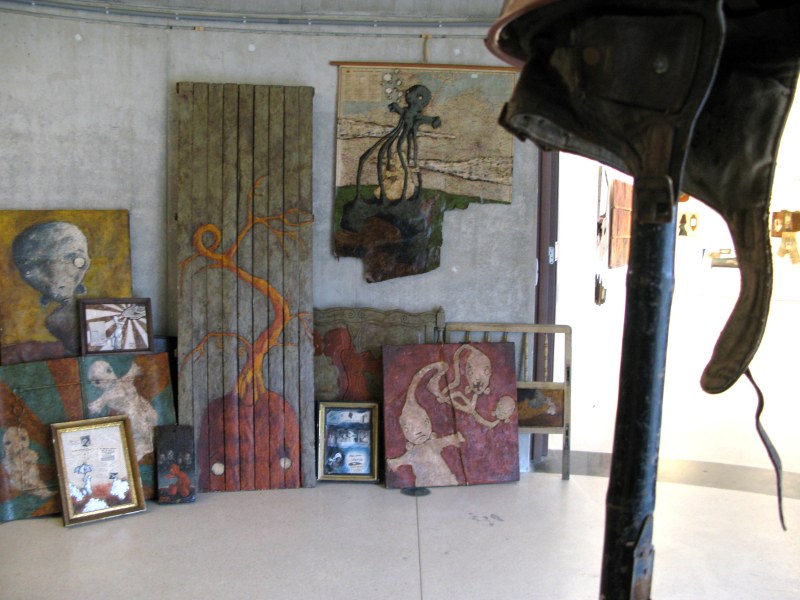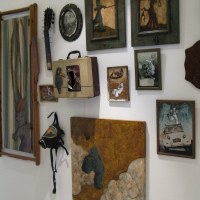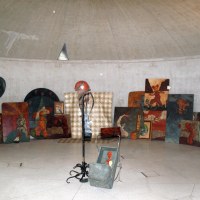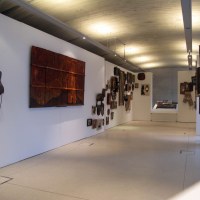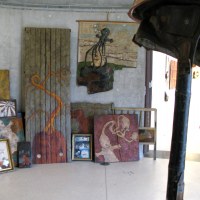Hugues Bastin
As a general rule, I do not want to explain my paintings, so that the work is no longer one, but becomes an open field of possibilities for each spectator, free to find what he wants, to project it, or even to stage his desires or fantasies, without being limited by my will. But it is mainly about the message that lurks in each of my paintings taken apart. Now, I think there are things to understand that deserve to be explained with regard to my approach in general.
The drawings:
I was inspired by comics, illustration, graphic design and some painters from street art or rock imagery. What I was mainly trying to find by turning to this kind of mode of representation was a character to whom anything and everything could happen, without my sense of logic putting a stop to it. In other words, I wanted to create a universe that allows me to use certain tools of surrealism such as, for example, this desire to let the unconscious express itself. When I draw my projects, I first simply put my pencil on paper; I draw a few strokes and then an image imposes itself on me: I am then content to copy it. Most of the time, therefore, I work on a project. In fact, there are times when ideas flow, and then others when it's dry breakdown. So I started making plans so I could also paint when I didn't have the necessary ideas. That being said, this mode of operation does not prevent me from working without relying on a project when an idea is imposed on me only by looking at the support.
For the character, I did some research for a year and a half before I came across the one I could use in my paintings. He had only a trunk and a head, and then, little by little, as I learned to feel comfortable with him, he acquired four limbs, gained a few pounds and looked good. I wanted it to be endearing to make my ideas (which are usually quite dark) accessible to all. It's a recurring theme in my work: appearances. Or, more accurately, the judgment according to appearances. When you judge my paintings at a glance, you see something childish, unreal, that doesn't exist. And yet, if we dwell on it and take the trouble to read the titles given to the paintings, we often realize that we were far from the count ...
I explained above my way of carrying out projects, I still wanted to clarify one thing: I never decide a theme in advance. It would even be quite the opposite, since it usually takes me quite a while to understand what the drawing represents. In any case, themes always have to do with my intimacy, what I experience, what I observe around me, events that trouble me, worry me or affect me. That said, there are some paintings that, I must admit, make no sense... it's just that what is represented, associated with the title, makes me smile...
The titles:
As far as titles are concerned, I usually give them as soon as I finish painting. When I still don't know what it represents exactly. I sit in front of her and dozens of words and associations of words scroll through my head until I find the one that will fly. It is only later, once I have taken the necessary step back, that I realize everything that connects the elements of my painting (title, support, drawing,...) between them and my own life: the whole thing then takes on a meaning.
The media:
As soon as I started working on my own creations, at the age of fifteen, I started to recover my supports a little anywhere, whether it was frame bottoms, pieces of fabric or old yellowed and spotted architectural plans. Then I quickly preferred the plywood plates that I found on the street or that an electrician uncle, recovered for me on construction sites. I've always preferred rigid surfaces... In fact, even now, when I stretch a canvas, I place a cardboard plate under the fabric to solidify the surface a little.
Then, when I started living in Liège, to go around the bulky from time to time picking up parts of cabinets or desks, in fact anything provided it has a flat surface, and it is wooden. Until then, I was recovering my supports mainly for the sake of economy, this kind of board being in abundance in the streets, it allowed me to be able to paint as much as I wanted without having to spend a franc elsewhere than in the painting itself. Then I wanted to highlight the fact that my media had had another function before. So I started to favour broken or badly cut boards. Each board having a different shape, defined completely randomly, I began to realize that this small difference actually brought an identity to each of the paintings, it made them unique, in a way.
For a year, I no longer had the opportunity to set up a workshop, it was during this period that I did most of my research. That's when I made, with one of the character's first throws, a comic book called "The Stupid and Ridiculous Stories". After this year without painting, I resumed my studies in 2ndbac painting in Saint Luc. At first, I stole some drawing boards that no one used in the workshop and retrieved some objects from the school's garbage cans and then, around December, as if something had unlocked in my head, I had the idea to direct instead my search for supports towards objects of everyday life, recognizable objects, and no longer persist in respecting more or less the square or rectangular formats generally imposed by the canvases. It must be said that, now that I live in Outremeuse and I have the flea market of Saint Pholien every Friday morning at the end of my street, the choice of objects that I can find in the garbage has greatly expanded.
On the other hand, I don't really know how to explain what makes one object more interesting to me than another. That said, there is one element that is the basis of each of my choices: the object must carry within it the history of its past. I always have a soft spot for broken or very deteriorated objects. Finally, anything that bears the marks of its past. Recovering any object, in addition to giving an identity to each of the paintings, creates a very special or, in any case, unusual universe. In addition, it reinforces the reflection on the superficial side of things, appearances. These are objects destined to disappear, which no longer even attract a single glance from passers-by when they are placed along the facades in the street waiting for the pickup truck and which, once they are brushed with paint, start to arouse interest again. Then people buy them and install them in their living rooms, kitchens or bathrooms, what do I know?
There, I must still specify that I usually only clean the surface that I will paint, the rest of the support, I do not touch it. It remains intact from the moment I took it out of the trash until someone bought it.
Painting techniques:
First of all, I never mix, either before painting or on the medium itself. I use the color as it comes out of the pot. My technique is actually an overlay of different layers. To begin with, there is the preparation of the support: lightly sand the varnished wood or plastic parts before passing a layer of primer and then drawing the sketch, or, when it comes to untreated wooden parts, first draw the sketch before extending a simple layer of white acrylic (leaving the outline of the apparent sketch on the wood will prove useful , i.e. the layer of walnut scramble). When this first layer is dry, I choose the colors of the last coat of paint, which will determine the color of the bottom layer. For example, under the yellow, I put red, under red, yellow or brown depending on the mood I seek to obtain ...
In general, there are only two layers of color. I arrange the first rather coarsely, with a large brush and following the outlines of the sketch, for the second, on the other hand, I apply a little more: most of the time I try to use for this layer the driest paint possible, the goal is not to cover but to create a material effect. For example, for a large area, I prefer to use a small brush, which gives the impression, in the end, that the surface vibrates. When the support allows me, i.e. in the vast majority of cases, I paint the character with a kitchen fork (and with a small fork of plastic fryer for the smaller sizes). Other times, as with clouds for example, I extend this layer of the thumb dish to avoid brushstrokes. From time to time, I add sawdust, sand or scum swept into my workshop to create no more "effect" of matter but of the material at all.
I then spread a layer of walnut scramble over the entire painted surface, until I get a large puddle that I let dry. Then I clean it with a sponge trying to highlight the small irregularities of the paint that the nut scramble pointed out. Finally, I varnish everything because, in my opinion, the nut scramble is a little too fragile: a drop of water and it disappears, as if by magic ...
The collages:
Again, I turned to materials that have already lived well. I picked up several stacks of magazines published between 1920 and 1960. What I like most about it is all these little details that, despite their old side, remind us that things have not evolved as much as one might think. Although there are still some small notable differences such as, for example, the abundance of advertisements encouraging weight gain.
I try to use all these old-fashioned images, these stale advertising slogans, these headlines of rowdy articles to spread messages about things that concern us all today. But, again here, I will persist in not explaining anything, even if the use of words allows a fairly easy interpretation (but not necessarily judicious), because I care a lot about the fact that my work can be understood in a thousand different ways. There is not only one way to understand what I am doing and I would take a risk if I began to explain everything I feel like I see in my paintings. I think most people wouldn't look any further...
I first made a small book that contains about thirty collages to test the idea I had and verify that it could fit on the length before moving on to the making of exhibitable pieces. In fact, it took me a long time to decide to take the plunge. I didn't know how to present that. At first I thought about sticking them on old wooden planks, but the ones I found most often were not interesting enough. I then thought about making my collages in drawers and, coincidentally, from the moment I started looking for them, it looked like there was a shortage of drawers in the garbage: impossible to get hold of only one of them. And then one day, walking up and down the Boulevard de la Constitution at the pace of running to search the garbage cans of the flea market, I found a whole bunch of old frames with blows everywhere, sometimes even totally dismantled. I had come up with the idea I was looking for.
The music:
This section is more specifically about exposure to the Orangery. In fact, the term "music" may not be very well chosen, I think "soundscape" would be more appropriate. I composed music from sounds recorded by Aaron Ximm. He practices field recording and offers a wide selection of free samples on his website. Field recording is the fact of recording sounds in nature to make music or to embellish the recordings of certain groups. Aaron Ximm's musical project is called Quiet American, it is also the name of the site where you can find, in addition to the recordings of American Quiet, all the free samples: http://quietamerican.org. So he proposes sounds that he recorded during various trips to Laos, Vietnam, San Francisco, ...
These sounds make up the eighty percent of my CD, the rest are additions of piano parts (played and composed by me), parts of electronic music of my composition, songs of whales and a little double bass. I mixed all this with a fairly rudimentary program consisting of a single track on which I stuck each sounds without having the ability to go back. This explains some small errors that I was forced to pass up. In fact, I composed this CD based on my painting technique, i.e. the layering of different layers. I wanted to create a homogeneous whole that invites contemplation, introspection. Bringing an atmosphere not really disturbing but not really reassuring either, like my paintings.
By adding this soundscape to my exhibition, I want above all to create a break with the outside world, that the visitor has the impression of passing so to speak in a parallel universe. I wish it wasn't just an exhibition to visit, but an experience to live.
I was only able to test the addition of music once, during my graduation jury in Saint Luke last June. Unfortunately, I had no feedback from what the jury had thought of. In addition, I noticed on the day of the opening of the school's exhibition, a week later, that someone had stolen the diffusers I had left in my exhibition space. So I couldn't test the effect of my music on the audience. So it will be, in a way, a bit like a first for me. Having said that, I realize that on the day of the opening, if there are even twenty people, we will not hear anything. So now all I have to do is hope that, in the days that follow, my plan will go as I imagined it...
